 |
 |
 |
 |
Watch The Program - Teachers
This two-hour program is divided into 16 chapters. Choose any chapter below and select QuickTime or Real Video to begin viewing. If you experience difficulty viewing, it may be due to high demand. We regret this, and suggest you try back at another time. Due to rights restrictions this program is not available for downloading.
Feedback |
Technical Help |
Program Credits |
Program Transcript
Advanced options |
Watch other NOVA programs online
|
 |
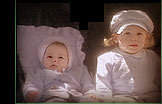
|

1. Instructions for a Human Being
This chapter:
- previews the program's focus on the race to decode the human genome and
raises some of the scientific and social ramifications involved.
-
notes that scientists have worked 10 years to read the entire human
genome.
-
explains that DNA is a chemical message that began more than four billion
years ago with the first signs of life on Earth.
-
describes the ladder-like structure and chemical makeup of DNA.
running time 09:06
|
|
watch it in
QuickTime |
RealVideo
|
 |
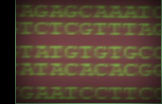
|

2. Getting the Letters Out
This chapter:
- notes that every human baby born is 99.5 percent identical to every other
baby.
- explains that the Human Genome Project is devoted to decoding and
understanding the small percentage of differences among humans.
- recalls that in the project's earliest days, reading the DNA code was a
timely and arduous process, allowing only a few hundred letters to be hand-read
each day.
- states that by using computers, the process was sped up to reading a
thousand letters a second.
- reviews some metaphors used to describe the decoding of all three billion
letters in the human genome.
running time 05:52
|
|
watch it in
QuickTime |
RealVideo
|
 |

|

3. One Wrong Letter
This chapter:
- describes parents Allison and Tim Lord, whose two-year-old son, Hayden,
was diagnosed with Tay-Sachs, an incurable degenerative brain disease.
- explains that Tay-Sachs is a one-letter mutation in the genome that
causes the gene it's on to create a faulty protein—one that is unable to
dissolve fat in the brain.
- relates that Tim's brother, Charlie, and his wife, Blyth, have also been
affected by Tay-Sachs. Of their two children, one is a carrier and the other
has the disease.
- notes that Tay-Sachs usually occurs in specific groups, like Ashkenazi
Jews, and must be inherited from both parents.
- states that the Human Genome Project offers the potential for people to
find out early if they are at risk for a disease, or for passing on a disease
to their children.
running time 08:57
|
|
watch it in
QuickTime |
RealVideo
|
 |
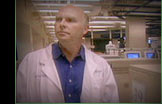
|

4. The Sequencing Race Begins
This chapter:
- notes that first and foremost, the promise of the Human Genome Project is
to allow for an early warning system for a host of diseases.
- introduces Craig Venter, the scientist who started Celera Genomics, a
private company devoted to decoding the human genome using a more efficient,
automated process than employed by most public labs at the time.
- explains how the automated DNA-reading process works.
- profiles Venter's background.
- reports Venter's 1998 announcement that he and his company were going to
sequence all 3 billion letters of the human genome in two years, a process the
government estimated would take 15 years.
running time 06:29
|
|
watch it in
QuickTime |
RealVideo
|
 |
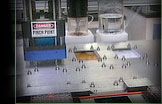
|

5. Ramping up
This chapter:
- recalls how everyone working on the public human genome project raced to
find ways to speed up their efforts in response to Venter's
announcement.
- notes that the public centers, which found ways to accelerate sequencing,
would nightly post their latest data on the Internet.
- reports that Celera used the Internet data posted by the labs.
- raises the question of why the government should fund research
duplicating that done by Celera.
running time 07:48
|
|
watch it in
QuickTime |
RealVideo
|
 |
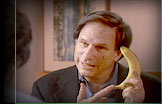
|

6. Genetic Variation
This chapter:
- reviews how both the public labs and Celera chose volunteers to submit
DNA for mapping.
- reports that human beings are incredibly similar in genetic makeup,
varying only about one tenth of a percent, less than chimpanzees, whose average
difference is four to five times more than the difference between any two
humans.
- states that the small differences in human's genetic makeup results from
homo sapiens being such a young species and descending from a very small
founding population.
- notes the similarities in DNA between humans and all other living things,
from bananas to baker's yeast.
running time 06:33
|
|
watch it in
QuickTime |
RealVideo
|
 |
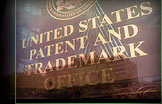
|

7. Who Owns the Genome?
This chapter:
- notes that the drive to complete the decoding process was partly
motivated by the fact that some people were trying to privatize the human
genome by patenting human genes they had decoded.
- reviews some arguments for and against patenting genetic code.
- states that there are 20,000 genetic patents under review in the U.S.
Patent Office.
- presents the effects of patenting on current research efforts.
running time 07:52
|
|
watch it in
QuickTime |
RealVideo
|
 |
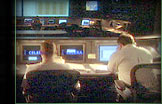
|

8. The Business of Science
This chapter:
- looks at the role of business in scientific advancement.
- describes Celera's main source of income—its fee-based Web site that
includes information on the genomes of several species, including fruit flies,
mice, and humans.
- notes how Celera's business model conflicts with the traditional way
science is done, which results are publicly shared with others who can then
freely build on those results.
running time 04:06
|
|
watch it in
QuickTime |
RealVideo
|
 |
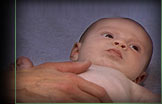
|

9. Finding Cures is Hard
This chapter:
- notes that it takes much more than knowing the sequence of DNA to find
cures for disease.
- profiles Rily Demanche, an infant diagnosed with cystic fibrosis (CF), a
disease that causes chronic respiratory infections.
- reports that while the genetic defect for CF—a three-letter error—was discovered in 1989, attempts at gene therapy have been unsuccessful to
date.
- states that scientists are now looking at ways to repair the proteins
involved in CF.
- notes that proteins and protein activities are what physically compose a
human being.
- relates that while genes are effectively a one-dimensional string of
letters, proteins are three dimensional.
- describes how a gene codes for an amino acid sequence that forms a
protein, which then forms a shape that defines its task.
- specifies how the misshapen protein involved with CF prevents salt from
leaving the lung cells, thus triggering a chain of reactions that causes the
cell to become covered with thick mucus, which must then be physically
dislodged.
running time 08:07
|
|
watch it in
QuickTime |
RealVideo
|
 |
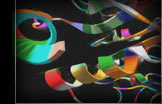
|

10. Complexity in Proteins
This chapter:
- presents the case of Tony Raimos, a patient who, though diagnosed with
CF, did not develop symptoms until she was 15 years old.
- relates the theory that Raimos may have other genetic mutations that have
kept her more healthy than most CF patients.
- introduces the search for the proteome—all the proteins that make up a
human being—as one of the next steps involved in understanding life at the
molecular level.
- notes that while researchers believed humans had about 100,000 genes,
they discovered only about 30,000 .
- reports that while humans only have about twice as many genes as a fruit
fly, human genes seem to code for much more complex proteins.
running time 07:44
|
|
watch it in
QuickTime |
RealVideo
|
 |
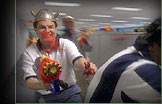
|

11. The Finish Line
This chapter:
- continues to track the race to decode the human genome.
- notes the atmosphere in Celera's labs in the final stretch of the
decoding race.
- cites some of Venter's reasons for wanting to decode the genome as
quickly as possible.
running time 04:32
|
|
watch it in
QuickTime |
RealVideo
|
 |
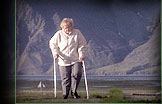
|

12. Finding Disease Genes
This chapter:
- explains how having the genome decoded should make it easier to find
causes for disease.
- steps through the process of how scientists might help pinpoint which
genes are responsible for which traits.
- showcases Iceland's database of almost every citizen's family tree as a
way to compare genetic histories and identify diseases.
- follows Kari Stefansson, a scientist who set up DeCODE Genetics in order
to combine Iceland's genetic histories with DNA analysis to pinpoint genetic
diseases.
- profiles the case of Regnheidir Magnusdottir, one of 11 out of 17
children in a family stricken with osteoarthritis.
- recounts how Stefansson offered a fee and profits to the Icelandic
government in return for exclusive access to the country's medical records, and
how the government and population of Iceland responded to the request.
running time 04:06
|
|
watch it in
QuickTime |
RealVideo
|
 |
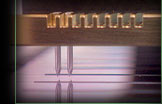
|

13. DNA Databases
This chapter:
- reviews some of the ethical issues surrounding the creation of DNA
databases.
* presents film clips from the movie GATTACA.
- explains how DNA chips would allow doctors to screen babies for numerous
diseases and discusses some of the implications of this type of
information.
running time 04:14
|
|
watch it in
QuickTime |
RealVideo
|
 |
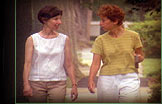
|

14. A Family Disease
This chapter:
- profiles Lissa Kapust and Lori Siegel, older sisters to youngest sister,
Melanie, who died of ovarian cancer when she was 30 years old.
- describes Lissa being treated for breast cancer when she was 34 and again
in 1996, about the time scientists were determining a familial link between
breast and ovarian cancers.
- reviews the mutations in two genes—BRCA 1 and 2 - which significantly
increase one's risk of developing cancer.
- follows Lissa and Lori as doctors test both for the presence of the
mutated genes, and raises the question of what having such a test might
mean.
running time 08:05
|
|
watch it in
QuickTime |
RealVideo
|
 |
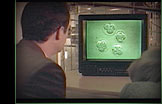
|

15. Genetic Modification
This chapter:
- presents a movie clip from GATTACA that illustrates the idea of
genetic enhancement of unborn children.
- explores how far humans may be able to go with genetic
manipulation.
running time 04:27
|
|
watch it in
QuickTime |
RealVideo
|
 |
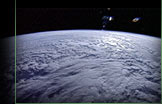
|

16. Contemplating the Message
This chapter:
- revisits issues arising from the privatization of decoding the human
genome.
- presents Celera and the public project scientists agreeing to share the
credit for sequencing the genome.
- explores the idea that the genome is very uneven—that is, that the
30,000 genes are not evenly distributed across the chromosomes.
- concludes with the idea that while humans are similar to every other
living thing on Earth, something extraordinary exists that makes them very
different.
running time 07:58
|
|
watch it in
QuickTime |
RealVideo
|